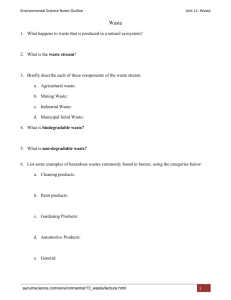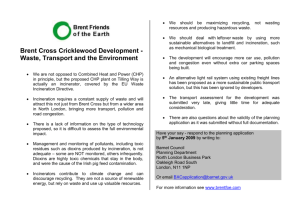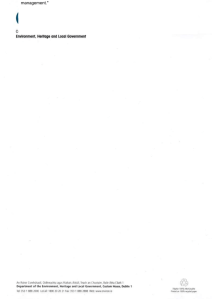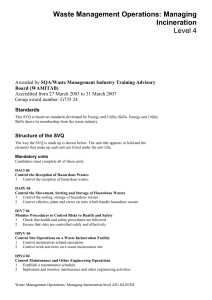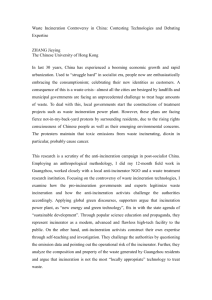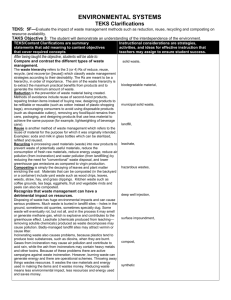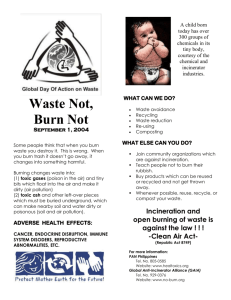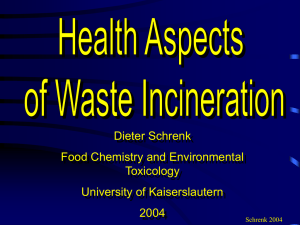Waste Management Test KEY (Answers in Red) Which of the
advertisement
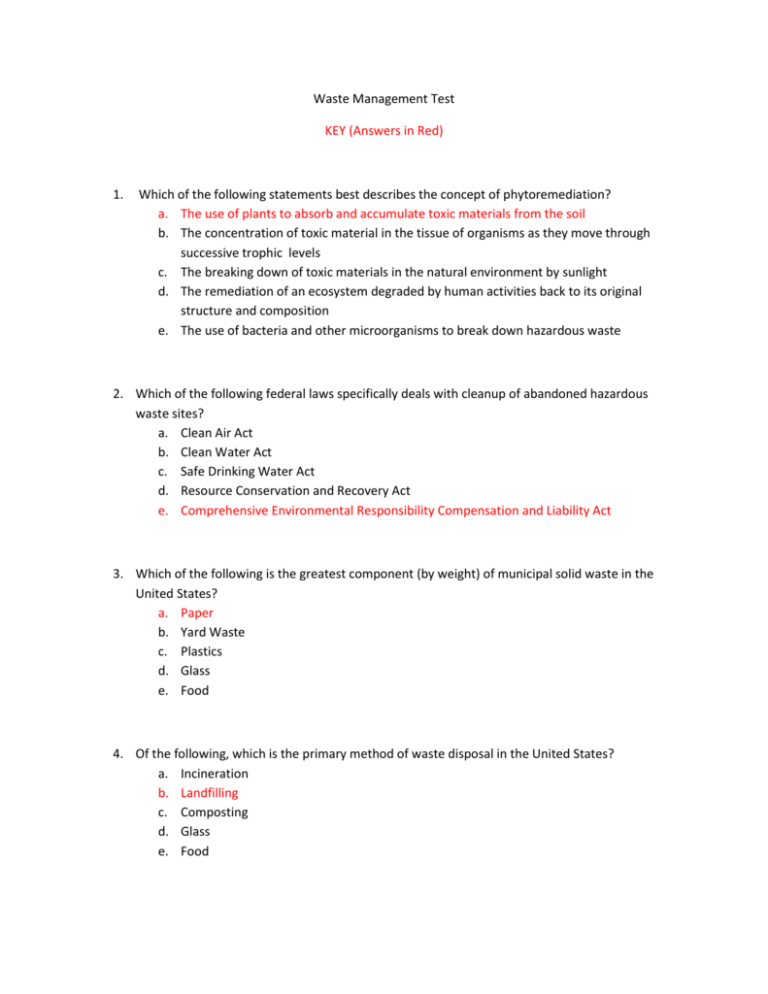
Waste Management Test KEY (Answers in Red) 1. Which of the following statements best describes the concept of phytoremediation? a. The use of plants to absorb and accumulate toxic materials from the soil b. The concentration of toxic material in the tissue of organisms as they move through successive trophic levels c. The breaking down of toxic materials in the natural environment by sunlight d. The remediation of an ecosystem degraded by human activities back to its original structure and composition e. The use of bacteria and other microorganisms to break down hazardous waste 2. Which of the following federal laws specifically deals with cleanup of abandoned hazardous waste sites? a. Clean Air Act b. Clean Water Act c. Safe Drinking Water Act d. Resource Conservation and Recovery Act e. Comprehensive Environmental Responsibility Compensation and Liability Act 3. Which of the following is the greatest component (by weight) of municipal solid waste in the United States? a. Paper b. Yard Waste c. Plastics d. Glass e. Food 4. Of the following, which is the primary method of waste disposal in the United States? a. Incineration b. Landfilling c. Composting d. Glass e. Food 5. Which of the following laws gave the EPA the authority to control hazardous waste from “cradle to grave”, including the generation, transportation, treatment, storage, and disposal of hazardous waste? a. Resource Conservation and Recovery Act (RCRA) b. Endangered Species Act (ESA) c. Comprehensive Environmental Response, Compensation, and Liability Act (CERCLA) d. National Environmental Policy Act (NEPA) e. Pollution Prevention Act (PPA) 6. In the United States, most municipal solid waste is disposed of by a. Composting b. Recycling c. Incineration d. Ocean dumping e. Landfilling 7. An advantage of recycling aluminum rather than disposing of it in landfills is that aluminum can be a. Produced from recycled metal using much less energy than is required for its production from aluminum ore b. Produced from ore that is chemically reactive and dangerous to transport, store and process c. Produced from ore that is scarce and found primarily in remote, inhospitable regions at high latitudes d. Absorbed by plants and then biomagnified in both terrestrial and aquatic food chains e. Leached form landfills in the form of Al+3 ions that could increase the pH of lakes and streams 8. Regulations that deal directly with the disposal of hazardous materials in the United States include which of the following? i. RCRA ii. Clean Water Act iii. Clean Air Act a. I only b. II only c. III only d. I and II only e. I, II and III 9. Critics of incineration of municipal solid waste suggest that it may not be the best solution for the future, for which of the following reasons? a. Incineration produces ash that increases landfill volume. b. Incineration generates methane. c. Incineration involves advanced technology. d. Incineration contributes to air pollution. e. Incineration requires large energy input. 10. Integrated waste management employs all of the following EXCEPT a. Using refillable soft-drink bottles b. Using disposable diapers instead of cloth diapers c. Using reusable canvas bags instead of plastic or paper bags d. Using tires for the construction of artificial reefs e. Redesigning automobiles to replace steel parts with aluminum and plastic parts 11. Which method reduces the volume of waste but could release toxic emissions into the atmosphere? a. Sanitary landfill b. Incineration c. Discharge to sewers, streams, and rivers d. Chemical treatment e. Biological treatment 12. Which method is used most frequently in the United States today? a. Sanitary landfill b. Incineration c. Discharge to sewers, streams, and rivers d. Chemical treatment e. Biological treatment 13. Is a flammable gas produced by landfills a. Carbon dioxide b. Carbon monoxide c. Methane d. Radon e. Sulfur dioxide 14. All of the following are considered toxic metal pollutants EXCEPT a. Cadmium b. Chromium c. Lead d. Mercury e. Potassium 15. Of the following, which is the most serious immediate problem associated with sanitary landfills? a. Generation of CO2 gas b. Leachate contamination of groundwater c. Release of disease organisms d. Incomplete degradation of wastes e. Compaction and settling 16. Which of the following correctly orders the methods of solid-waste management in terms of energy required? Least Energy -> Most Energy a. b. c. d. e. Reuse Recycle Recycle Reduce Reduce Recycle Reuse Reduce Reuse Recycle Reduce Reduce Reuse Recycle Reuse


